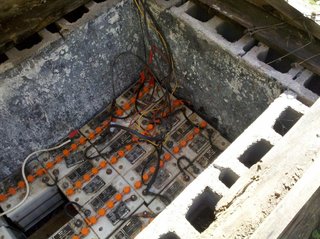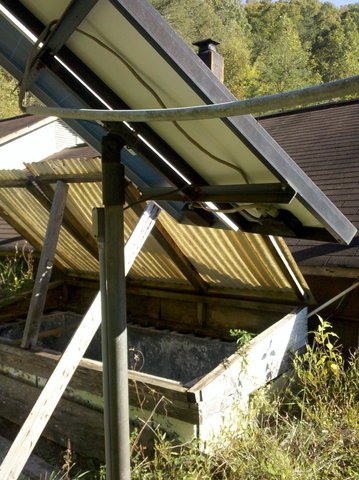I should probably have researched the batteries in this old solar-powered house before I installed a charge controller. I had assumed that the 24 6-volt batteries in the house's battery bay were standard lead-acid deep cycle batteries. It wasn't until I stumbled over a receipt from 1997 that I learned that the batteries are really NiCads. Specifically Saft model STM5-180.
 Thirty of these were purchased in 1997 from
TVA in Chatanooga,
for $350 total. An amazing price, since a single deep cycle battery is
in that ballpark, new. These batteries were used, they had been in a "bus" --
perhaps it was a
1995 Chrysler TEVan, or
maybe one of the pilot electric buses running there in the late 90's.
They were probably not in
this '79 VW TVA Bus.
All mentions of these batteries I can find involve electric vehicles --
it's unusual for them to be used to power a house.
Thirty of these were purchased in 1997 from
TVA in Chatanooga,
for $350 total. An amazing price, since a single deep cycle battery is
in that ballpark, new. These batteries were used, they had been in a "bus" --
perhaps it was a
1995 Chrysler TEVan, or
maybe one of the pilot electric buses running there in the late 90's.
They were probably not in
this '79 VW TVA Bus.
All mentions of these batteries I can find involve electric vehicles --
it's unusual for them to be used to power a house.
Being vented NiCads probably accounts for these batteries' long useful life -- surely at least 15 years. Still, with only twenty-four good ones left, they are probably toward the end of their lifespan and need to be taken care of in order to last.
Once I realized they were NiCads, I knew the charge controller was charging them wrong. NiCads like to be charged at a higher voltage than the 13 or so volts used for lead acid. I would have liked to charge them at 16 volts, but that would feed back through the house wiring, and could fry 12 volt stuff. Checking ratings, 15 volts seemed the highest voltage I could risk.
Coming back a week later, I found the batteries charged up to 13.4 volts. And they are now working great. Through several cloudy days, we had all the power we needed. And when the sun was out fully, I sometimes saw the solar panels charging the batteries at 125 watts -- fully half of the panels' rated capacity, and much better than before. The batteries start each evening at 13.4 volts, and only drop to 13.3 by morning. We started using electric lights more, and then just leaving them on all evening, and the nslu2 online all night, and the batteries remained at the magic 13.3 in the morning. This is because NiCad batteries have a near-constant voltage until they are perhaps 30% discharged. In other words, I had been charging them less than half full before.
I have figured out how to combine the two banks the batteries are in into one large bank, and once I get the cables to do that, I hope to have battery capacity to get through up to a week of solid clouds in midwinter.
 |